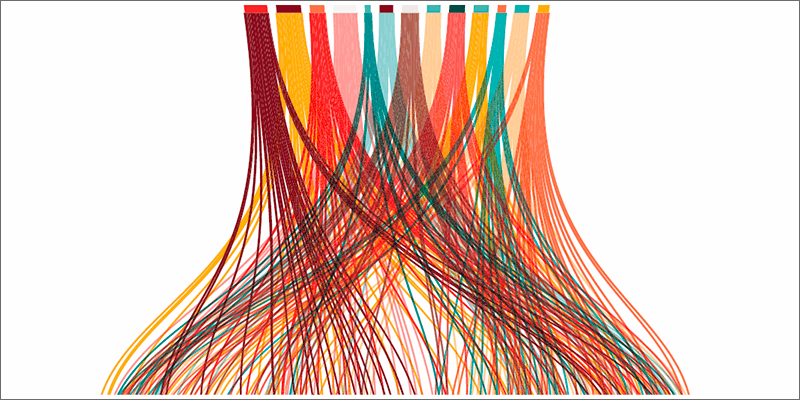We interviewed Eduardo Sánchez Delgado, deputy director of the MAPFRE Actuarial Area
INTERVIEW ISABEL GARBISU | PHOTOGRAPH MAPFRE | ILLUSTRATION ISTOCK
Eduardo Sánchez Delgado, assistant general manager of MAPFRE’s Actuarial Area, has a doctorate in Insurance Sciences and is an actuary, statistician and economist. In this interview he shares his knowledge of big data, its use in predictive models and its application to the insurance world. And he reassures us about how our data is being used.
What do we mean by big data?
The big data concept is all the rage. Hardly a day goes by without hearing something in the news or reading an article related to this term. However, there is no single definition of what it is and means.
Literally, we are speaking about huge volumes of data. The term can be traced back to 1997, when NASA researchers used it in an article outlining the difficulties involved in processing enormous volumes of information.
In the year 2001, the “three Vs” were used to describe its characteristic features:
- Volume. The massive amount of data generated and stored by organizations.
- Velocity. The data are transmitted and processed at great speed.
- Variety. The data available are drawn from very different sources and are in different formats.
Following this characterization of big data, other features have emerged that incorporate new Vs and offer an extended, more complete definition.
My attempt at defining big data would be the analysis of massive amounts of data drawn from different sources, which are handled and processed at high speed to offer companies added value in their decision-making processes.
What are the sources used to harness Big data?
The digitization of the world we inhabit is what has paved the way for the creation of enormous volumes of new data. Firstly, with the Internet of Things, which consists of the incorporation of metric sensors in gadgets such as smartphones, activity bracelets or GPS devices in order to connect to the Internet and store information without the need for human intervention. Secondly, with the rise of social media, constantly generating information about our habits and tastes. In addition, other information that feeds into big data is that related to transactions, such as credit card payments, biometric information such as facial recognition or DNA, and that generated by individuals, such as emails or recordings with telephone operators.
What use is it?
For big data to be useful, it is necessary to incorporate intelligence through the application of predictive statistical models. We can thus make predictions about uncertain future events.
The relevant factor is not so much the volume of information available, but rather using it to explain what you want to analyze. In that sense, I like to speak not only of big data, or its counterpart small data, but rather smart data. Smart data focuses on the quality, rather than the quantity, of information, so necessary to be able to adequately predict what you want to analyze.

MAPFRE was a pioneer in spain in the use of big data for automobile insurance products with the launch of YCAR over ten years ago now
So, should we also talk about small data or smart data when it comes to making a predictive model?
Predictive models help us respond better to a business need. Therefore, the first step is to analyze what metric is needed for the decision-making process. Secondly, we must seek out the various different data sources. Many of these data will most likely be internal and small data. What’s more, we must consider whether the big data sources provide additional information that could help improve predictions. All relevant information and its analysis will shape the smart data. My recommendation is to always try to use the company’s internal structured databases before turning to external sources. The internal information is usually easier to obtain and process, and is often more predictive than external data and more valuable for informed decisionmaking.
What kinds of analyses are done in insurance predictive modeling?
There are a large number of predictive models that are suitable for use in the various areas of insurance activity. The first and most obvious is the calculation of premiums. The actuaries calculate the premium based on a prediction of the average cost and frequency of the claims that clients are likely to make. But there are also a significant number of additional applications: prediction of the probability of death; fraud detection in underwriting or in the event of a claim; models for highly litigious, high cost or catastrophic claims; customer acquisition and retention; up-selling and cross-selling; customer value; payment defaults; gauging solvency capital requirements; and, even, employee turnover.

Is big data being used in those models? Has MAPFRE used it?
Big data likely to be included in the insurance world could be the information from devices installed in vehicles (GPS), households (sensors forming part of home domotics systems), or on people (sports activity bracelets). Another source could be related to interactions with clients or agents, such as contacts by telephone, email, aggregators or online tracking of mouse clicks. Finally, information on social networks can also be used.
MAPFRE was a pioneer in Spain in the use of big data for automobile insurance with the launch of its YCAR product over ten years ago now. Designed for young drivers, a GPS device was installed in the vehicle and the tariff calculation incorporated certain variables traditionally used, but also others related to driving time and style. This allowed the price of the insurance to be further adjusted and discounts applied to good drivers. In addition, policyholders were offered services such as a direct connection to the emergency services in the event of an accident.
MAPFRE has mechanisms in place to ensure anonymous processing of customer data and full compliance with the highest standards as regards the protection of personal data
Has big data brought about a big change in the insurance industry?
Not just big data, but also artificial intelligence, the Internet of Things, blockchain technology and virtual reality are all elements that are transforming the insurance world.
Moreover, we are creating innovation platforms where insurance companies collaborate with start-ups linked to the insurance business. Many of these insurtechs propose predictive models that use big data.
What projects are ongoing in MAPFRE right now?
Within its strategic plan, MAPFRE envisages advanced analytics as one of its initiatives. Within this area, predictive models become a fundamental element in decision-making processes based on the intelligence we garner from all information, including big data. In addition, the SAM 3.0 strategic initiative carries out projects related to new trends in the automobile world, such as the connected or autonomous car, or pay-per-use systems in insurance. In this initiative, new possibilities are being explored for incorporating big data in order to further personalize the insurance offering.
The Corporate Actuarial Area is promoting the use of new predictive techniques, such as machine learning which, together with more traditional techniques, improve the predictive ability of the tariff and technical provision calculation models throughout the MAPFRE companies.

What benefits can big data bring us?
It can help improve decisionmaking processes within insurance companies. Moreover, the benefits are also passed on to customers. Firstly, because the companies will be offering products more closely tailored to customers’ specific needs. Secondly, because monitoring behavior via connected devices such as activity bracelets, smartphones or other domestic devices, will enable customers to enhance their knowledge and adopt preventive measures to ensure they look after their health better or make more efficient use of their assets.
There should be a balance between the individualization of the risk and the principle of risk compensation to which insurance is socially committed
What are the challenges posed by big data?
Everything related to the privacy of personal information and, in the insurance field, the possible loss of the risk mutualization component of premium calculations.
With respect to privacy, MAPFRE has mechanisms in place to ensure anonymous processing of customer data and full compliance with the highest standards as regards the protection of personal data.
In relation to the loss of the risk mutualization and compensation component in premium calculations, I believe there should be a balance between the individualization of the risk and the principle of risk compensation to which insurance is socially committed.




